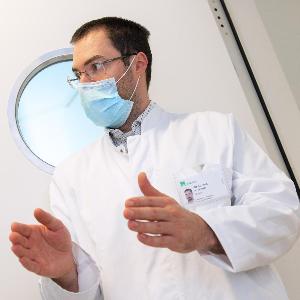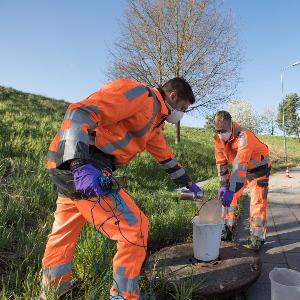Epidemics: Warning signs from the water
8 Dec 2021
Covid-19? Antimicrobial Resistance? Whatever the case, Andreas Wieser from the Division of Tropical Medicine uses wastewater to study the spread of disease.
8 Dec 2021
Covid-19? Antimicrobial Resistance? Whatever the case, Andreas Wieser from the Division of Tropical Medicine uses wastewater to study the spread of disease.

© IMAGO / Future Image
For a team headed by the Division of Infectious Diseases and Tropical Medicine, following the trail of a pathogen involves a deep dive through a manhole. In the depths of Munich’s sewer system, the team is tracking down the Covid-19 pandemic. “The sewage from a large city is a source of all kinds of information,” explains Andreas Wieser, Senior Physician at the University of Munich Hospital’s Division of Infectious Diseases and Tropical Medicine. “This is because pathogens find their way into wastewater via feces and urine. And it is important to remember that many Covid patients also suffer from diarrhea.”
In the summer, Wieser’s research team raised eyebrows with the first and (so far) most exhaustive study on monitoring sewage to track the SARS-CoV-2 virus in Bavaria – a study in which the Max von Pettenkofer Institute, the Gene Center Munich, the City of Munich’s Department of Health, the Bavarian Health and Food Safety Authority and other organizations were also involved.
The findings from samples taken across the City of Munich over the course of a year confirmed wastewater monitoring’s potential as an early-warning system for new waves and virus variants. Not only did the data align with the official reporting figures that were based on respiratory smears – it was actually three weeks ahead of the curve. Wieser admits that the reasons for this head start remain unclear: “And they are actually puzzling, because you first need a sick person who has something to excrete.” That said, the same phenomenon has been observed in other countries, too, and may be attributable to statistical distortions in the reporting figures.

Tracking down the Covid-19 pandemic in the depths of Munich’s sewer system: Andreas Wieser. | © Credit: LMU Klinikum
Especially when monitoring Covid-19 in Munich, one problem the professor encounters is the inability to use the sampling systems at the points where wastewater flows into the sewage treatment plants. These are the samples local government routinely uses to measure the composition of wastewater and, for example, its putrefactive bacteria. “SARS-CoV-2 is a fairly unstable virus that breaks down quickly in water,” Wieser explains. “And if the path from toilet to the waste water treatment plant is too long, only a small fraction of the virus gets there.” This effect, he adds, is further enhanced by the warmth of the wastewater due to putrefaction processes, ground heat and hot water from showers and baths.
Another problem is the special structure of Munich’s sewer system, which, on the initiative of far-sighted hygienist Max von Pettenkofer, was generously dimensioned at the end of the 19th century. “To avoid overloads and blockages, many diversions have since been fitted. As a result, however, the viral load at the point of entry to a sewage treatment plant can no longer be linked to a certain number of people.” For this reason, samples taken at precisely determined points with representative flow patterns are used to monitor SARS-CoV-2.
Polio in particular is a classic example: With a global network, wastewater from airports are examined for polio pathogens. The WHO repeatedly issues alerts whenever wild polio viruses are detected in the sewers of such hubs.Andreas Wieser
Covid-19 is far from the only application for sewage monitoring, though: “For years, this practice has proven its value worldwide in the monitoring of fecally and orally transmitted diseases such as cholera and polio,” Wieser clarifies. “Polio in particular is a classic example: With a global network, wastewater from airports are examined for polio pathogens. The WHO repeatedly issues alerts whenever wild polio viruses are detected in the sewers of such hubs.”
The scientists at the Division of Tropical Medicine also take part in research into signs of antibiotic resistance in sewers – in Africa, too. They likewise play a part in ‘One Health’ projects, which investigate such topics as inter-dependencies between human and animal health and the environment in developing countries. Wieser explains: “If people in developing countries, say, live under one roof with their chickens and other lifestock, it is impossible to regard their health in isolation.” Here again, wastewater monitoring is applied: “Precisely because of our experience in this field, the Tropical Medicine team already had the knowledge they needed to be able to respond swiftly to Covid.”

Taking samples of wastwater (credit: Münchner Stadtentwässerung)
In the Bavarian capital, Wieser and his team have now modified their measuring strategy, doubling the once-weekly sampling cycle to avoid distortions caused by random outliers. At the same time, multiple automated sampling is evaluated to average concentration artefacts. On the other hand, some of what were originally six sampling points have now been discontinued. “We stopped taking samples from the hospital’s drains, for example, because that added no value for research into the virus – even though we were initially surprised by the exceptionally low viral load we found there.” But the reason was clear enough: “At such a specialized, high-tech hospital, you have far fewer patients than staff. And all of the latter are vaccinated, alongside the many tests that are conducted.”
One additional research target is to explore changes in the significance of measurements given that most of the population is now vaccinated. Going forward, Andreas Wieser believes it would be conceivable to specifically monitor wastewater from individual facilities. “We’re talking about schools and nursing homes, for example,” he says. “That way, we could more quickly track down – and respond to – local outbreaks.”
In light of all the experience gained, positive results and deployment options, Wieser is surprised that wastewater monitoring has not become more strongly institutionalized in Germany. “This method can complement existing data sources. At little expense, it can give us a different perspective on the problem,” the infectiologist says. “Yet Germany still has no relevant laws, no rules whatsoever. All we have is a recommendation by the European Commission to the EU member states to monitor wastewater in urban metropolises for SARS-CoV-2 and its variants.” He believes that political decision-makers must now anchor wastewater monitoring more firmly in infection control – in order to more effectively decipher the warning signs our water gives us.
To read “Spatially resolved qualified sewage spot sampling to track SARS-CoV-2 dynamics in Munich – One year of experience”, published in August in the journal “Science of the Total Environment”, go here: